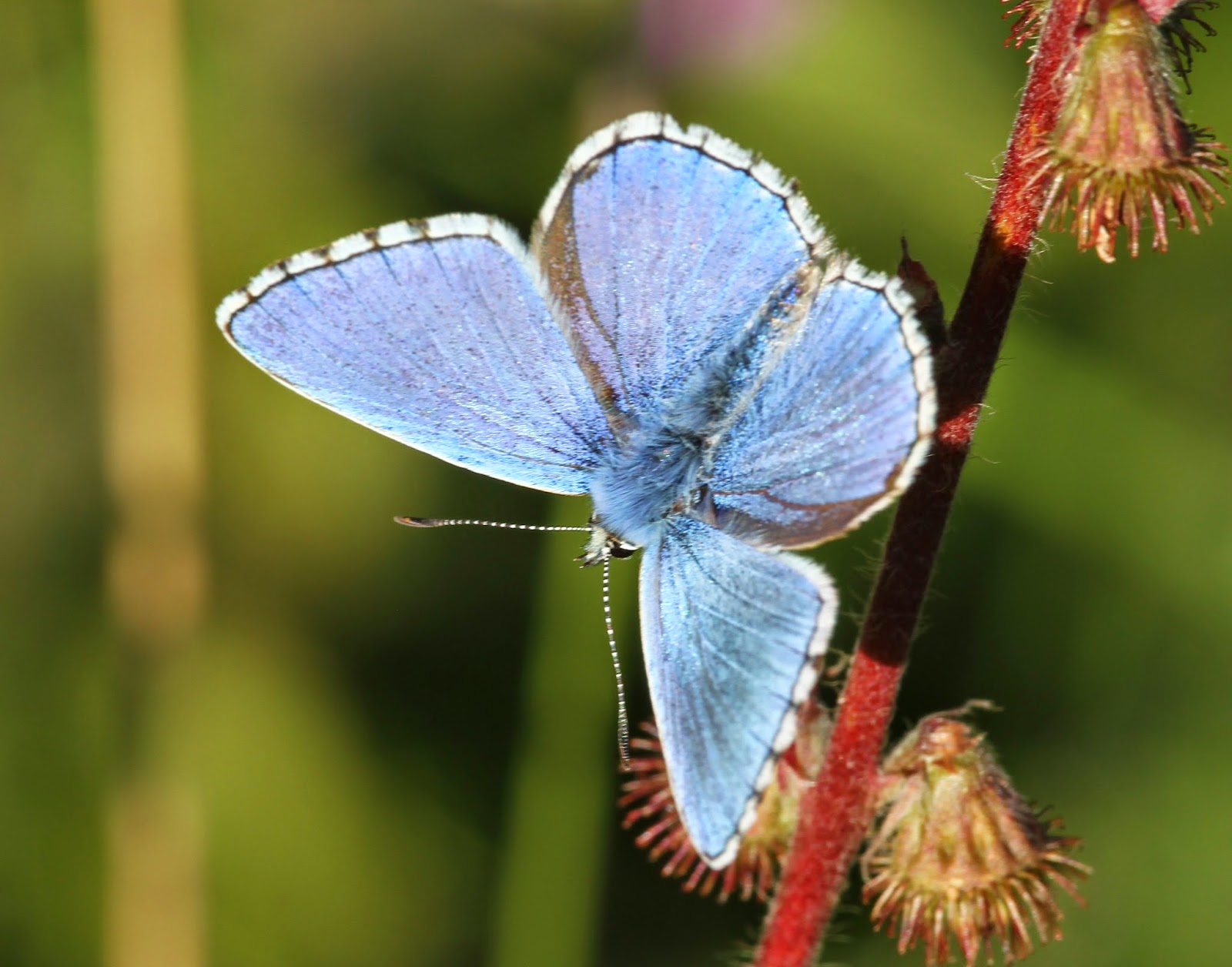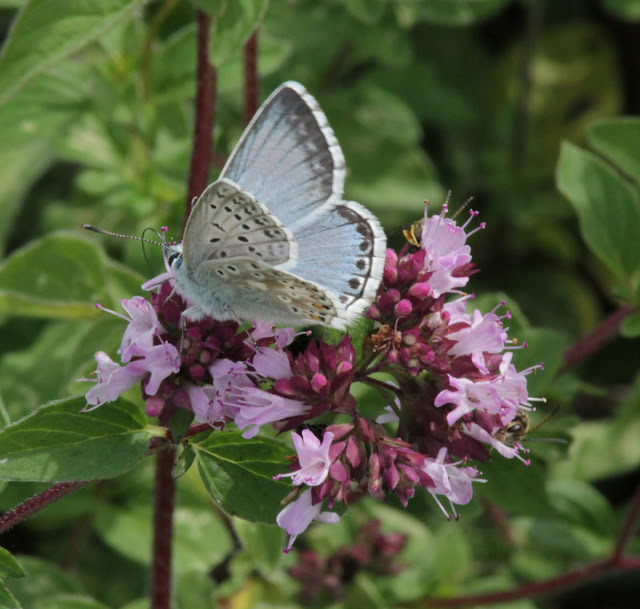This afternoon was rather overcast and cool, and I arrived at Queendown Warren at about half past two, stating until just gone five. As I parked up at the island the prospects didn't look particularly promising but the first wildflower patch did have over a dozen Meadow Browns, so there was limited encouragement there. Then I came across three Brown Argus there, and so I thought things were looking up a little. The next flower patch had both Brown Argus and Common Blues in reasonable numbers, and so I moved down to the bottom of the slope and picked up more of the same.
Through the fence and along to the next flower patch closer to the far corner and I was coming across Chalkhill Blues as well, and then finally the Adonis Blue, concentrated in the far corner. Good numbers of Lycaenids by now, all tending to sun, nectar and roost. I was using ISO 200 and I was quite happy with the picture quality, particularly when I switched to AV mode to ensure a slightly better depth of field. However I always have to watch our for motion blurring, either camera or subject so I need to keep an eye on the exposure speed when in AV.
This was a photo of a Brown Argus, Aricia agestis, possibly a female, partly shielded by foliage.
I got some nice photos of the male Adonis Blues. I don't think I noticed any females - they are more difficult to spot!
This is an Adonis Blue head close-up showing something of the eye colouration, antennal insertion above the ye, forehead tuft and maxillary palps.
The Adonis Blue has undergone great population changes over the last few decades, as befits a butterfly with a single food plant with highly exacting environmental requirements at the northern extremity of its range! Populations crashed very badly in the 70s in the UK, said to be due to the terrific drought of '76 affecting its foodplant the Horseshoe Vetch - God bless Dennis Howell who finally ended it by getting appointed as Minister for Drought, at which point the heavens immediately opened, creating floods!
Perhaps we should be seeing butterflies as extremely flaky organisms, subject to regular extinction and recolonisation in a very highly dynamic system. If this is so, then we would probably have very few species in Great Britain compared to Europe.....well, do the maths as the Americans seem to almost continually say! And populations should have remarkable powers of recuperation - the Adonis Blue is not a great spreader, in fact one of the worst, but it is rather good at recuperation - one colony increased from less than 50 to 60,000 in five years! There is also a theory with some considerable degree of backup from DNA evidence, that the current British population only arrived from Europe in the 18th Century. Perhaps then butterflies are not really the organisms best suited to act as the environmental canaries in the mine, being rather over-responsive!
Future conservation measures might be more solidly focussed if we knew more of the ecology of the Horseshoe Vetch. I wonder if we could now encourage it to grow in more diverse parts of Queendown, where it was introduced by KWT in 2002, with a greater variety of soil depth. That might give more resilience to the Adonis Blue in different summers and with different grazing intensities. Then we may need to do something about its lack of mobility - carefully! It seems to be doing OK in Kent, partly because of the reintroductions at Queendown and Darland Banks.
There are some excellent websites including this one "Learn about Butterflies".
Through the fence and along to the next flower patch closer to the far corner and I was coming across Chalkhill Blues as well, and then finally the Adonis Blue, concentrated in the far corner. Good numbers of Lycaenids by now, all tending to sun, nectar and roost. I was using ISO 200 and I was quite happy with the picture quality, particularly when I switched to AV mode to ensure a slightly better depth of field. However I always have to watch our for motion blurring, either camera or subject so I need to keep an eye on the exposure speed when in AV.
This was a photo of a Brown Argus, Aricia agestis, possibly a female, partly shielded by foliage.
I got some nice photos of the male Adonis Blues. I don't think I noticed any females - they are more difficult to spot!
This is an Adonis Blue head close-up showing something of the eye colouration, antennal insertion above the ye, forehead tuft and maxillary palps.
The Adonis Blue has undergone great population changes over the last few decades, as befits a butterfly with a single food plant with highly exacting environmental requirements at the northern extremity of its range! Populations crashed very badly in the 70s in the UK, said to be due to the terrific drought of '76 affecting its foodplant the Horseshoe Vetch - God bless Dennis Howell who finally ended it by getting appointed as Minister for Drought, at which point the heavens immediately opened, creating floods!
Perhaps we should be seeing butterflies as extremely flaky organisms, subject to regular extinction and recolonisation in a very highly dynamic system. If this is so, then we would probably have very few species in Great Britain compared to Europe.....well, do the maths as the Americans seem to almost continually say! And populations should have remarkable powers of recuperation - the Adonis Blue is not a great spreader, in fact one of the worst, but it is rather good at recuperation - one colony increased from less than 50 to 60,000 in five years! There is also a theory with some considerable degree of backup from DNA evidence, that the current British population only arrived from Europe in the 18th Century. Perhaps then butterflies are not really the organisms best suited to act as the environmental canaries in the mine, being rather over-responsive!
Future conservation measures might be more solidly focussed if we knew more of the ecology of the Horseshoe Vetch. I wonder if we could now encourage it to grow in more diverse parts of Queendown, where it was introduced by KWT in 2002, with a greater variety of soil depth. That might give more resilience to the Adonis Blue in different summers and with different grazing intensities. Then we may need to do something about its lack of mobility - carefully! It seems to be doing OK in Kent, partly because of the reintroductions at Queendown and Darland Banks.
There are some excellent websites including this one "Learn about Butterflies".

















